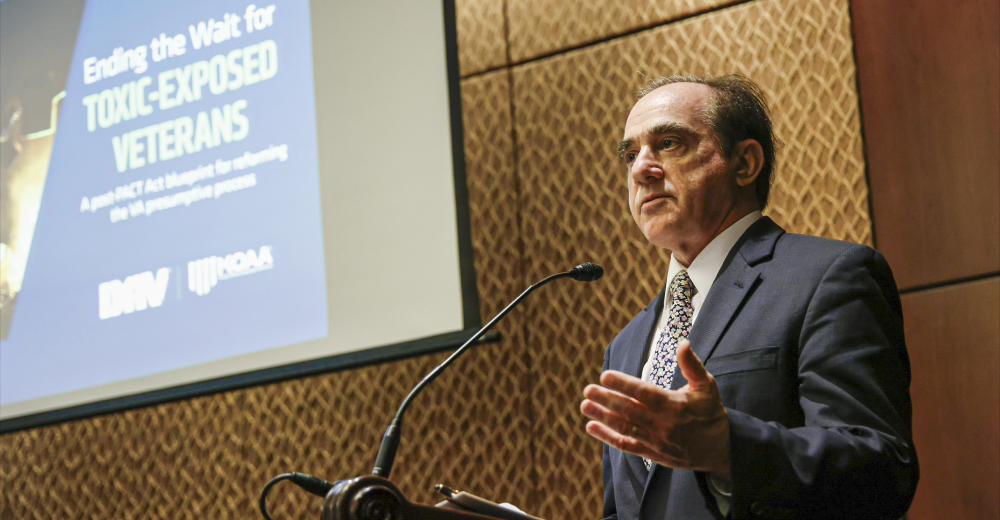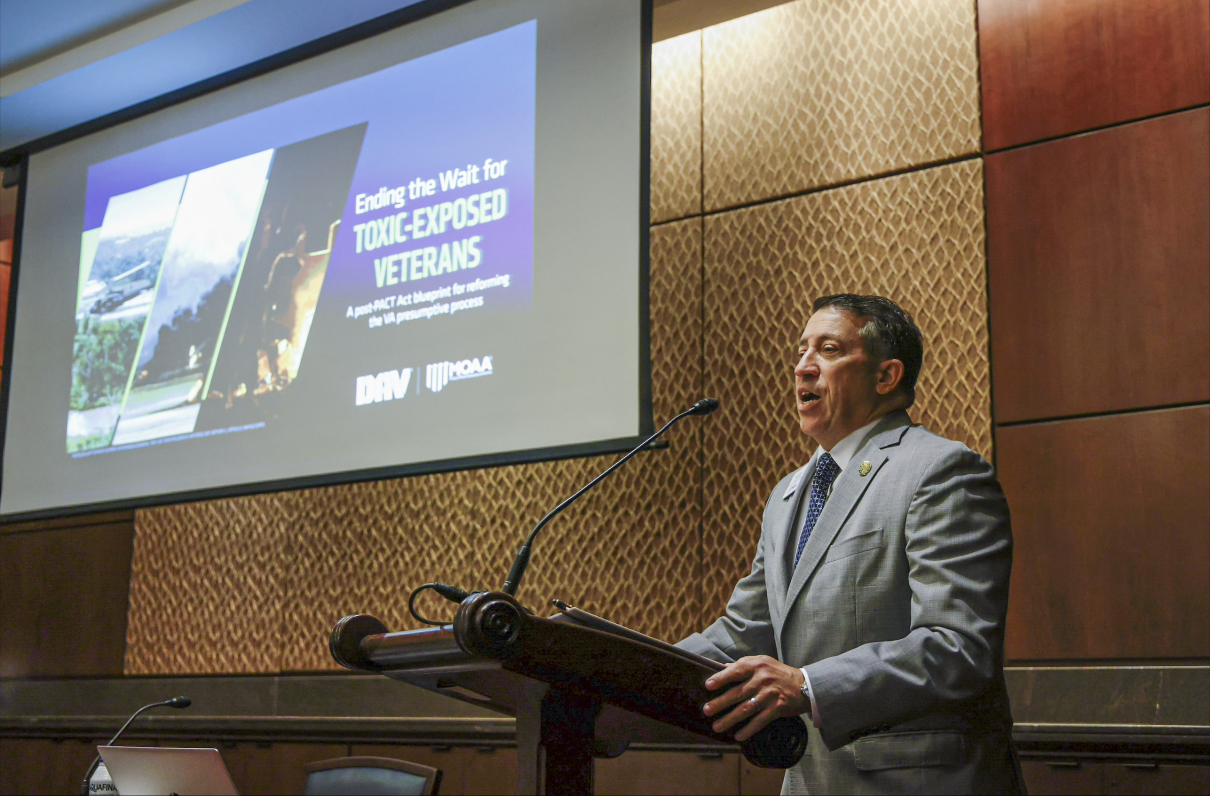By MOAA Staff
A teenage Marine stands guard as planes spray an airbase in Vietnam with a mystery substance. More than 60 years later, he finally receives VA benefits for his hypertension claim.
A soldier at an airbase in Uzbekistan suffers so many health issues he decides to keep a journal. More than 20 years later, facing thyroid issues and the bone density of an 80-year-old, he’s still ineligible for service-connected care.
A retired officer serves on a base with dangerous chemicals in its water supply at more than 80 times the prescribed federal limit. He and his fellow servicemembers remain in limbo as the VA takes years to consider their individual claims.
U.S. veterans have been exposed to toxins as part of service for more than a century. A new report from MOAA and Disabled American Veterans (DAV) dives into that long history, looking at how the VA and its predecessors have cared for those who serve … and recommending changes to a broken process designed to reduce the average time between an exposure and the receipt of full VA benefits – currently more than three decades.
“The military has a deliberate plan and effective system of operation for nearly everything, but when it comes to timely identification and acknowledgement of toxic exposures, we lack a system and are falling short – servicemembers in and out of uniform deserve better,” said Lt. Gen. Brian. T. Kelly, USAF (Ret), during a Sept. 18 launch event in Washington, D.C., marking the release of Ending the Wait for Toxic-Exposed Veterans, a report offering a blueprint for the VA to reform its toxic-exposure process and expand on generational progress made with the August 2022 signing of the Sergeant First Class Heath Robinson Honoring our Promise to Address Comprehensive Toxics (PACT) Act.
[RELATED: More Than 1 Million Veterans Have Received PACT Act Benefits]
Based on a detailed review of toxic exposures since World War I, and the response to those exposures from DoD and the VA (and their predecessors), the report offers four key recommendations:
- A three-part process to establish presumed connections between illnesses and exposures, which would create “timelines, triggers, thresholds and decisions” to steer the agencies from acknowledgement of exposure to providing needed care in a timely fashion.
- Expanded research and monitoring to better understand these exposures in real time, allowing better support for VA efforts to identify and care for veterans.
- A pre-separation enrollment into VA care for those in uniform, and the elimination of pay-as-you-go (PAYGO) requirements on toxic exposure-related legislation.
- A new classification system for toxic exposures – one that makes clear what evidence is lacking in specific cases and provides a path forward for both veterans and VA officials to fill in the gaps.
[COVERAGE OF 'ENDING THE WAIT': NBC News | Military Times | Stars and Stripes | Military.com]
“This report provides a crucial blueprint for necessary refinement and reforms to reach all who are in need,” Kelly said in a news release announcing the report. “It is our duty to ensure the sacrifices made to their health while protecting our freedoms are addressed, with nobody left behind to suffer in silence.”
Behind the Report
MOAA and DAV began work on what would become Ending the Wait before the PACT Act’s passage. The report’s authors shifted focus to look beyond that law’s improvements, laying the groundwork to ensure benefits do not lag future exposures.
“We call on the Department of Veterans Affairs and congressional leaders to join our growing coalition of veterans service organizations and other stakeholders to enact comprehensive reform so future generations of veterans never have to wait decades to receive the care and benefits they deserve,” reads the report, which includes:
- Stories of individual veterans (like those outlined earlier) whose personal timelines to receive care after exposure to toxins while in uniform has taken as long or longer than the overall average … or, in some cases, has yet to reach a conclusion, mired in VA claims work and an uncertain medical future.
- A deep dive into the history of toxic exposures, from World War I mustard gas to radiation experiments in the 1950s to the VA’s long struggle to care for all servicemembers who came in contact with Vietnam-era defoliants.
- A case study of the chemical exposure at Fort McClellan, Ala., outlining how proposed changes to the VA’s exposure framework could’ve trimmed the time between exposure and benefits for veterans and family members by a dozen years or more.
“We are proud to work with MOAA to propose a paradigm shift that finishes what the PACT Act started by comprehensively reforming the way the VA responds to toxic wounds,” DAV Washington Headquarters Executive Director Randy Reese said in the news release.
[RELATED: K2 Veterans With Unexplained Medical Conditions to Qualify for VA Disability Assistance]

Former Secretary of Veterans Affairs Dr. David Shulkin speaks during the Sept. 18 launch event in Washington, D.C.
The report’s release represents a significant milestone for MOAA in its work on ending the wait for these servicemembers, and it will serve as a base for more extensive advocacy efforts in the 119th Congress and beyond, said Cory Titus, MOAA’s director of Government Relations for Servicemember Compensation and Veterans Benefits.
“Armed with these findings, we’re able to work with lawmakers and their staffs to craft meaningful legislation designed to improve a flawed process,” Titus said. “Our research not only adds to our credibility on these issues, it shows how urgent further reforms are if we want to provide the benefits owed to our veterans, their families, and their survivors before it’s too late.”
Read the full report at this link.
When MOAA Speaks, Congress Listens
Learn more about MOAA’s key advocacy issues, and contact your elected officials using our messaging platform.
